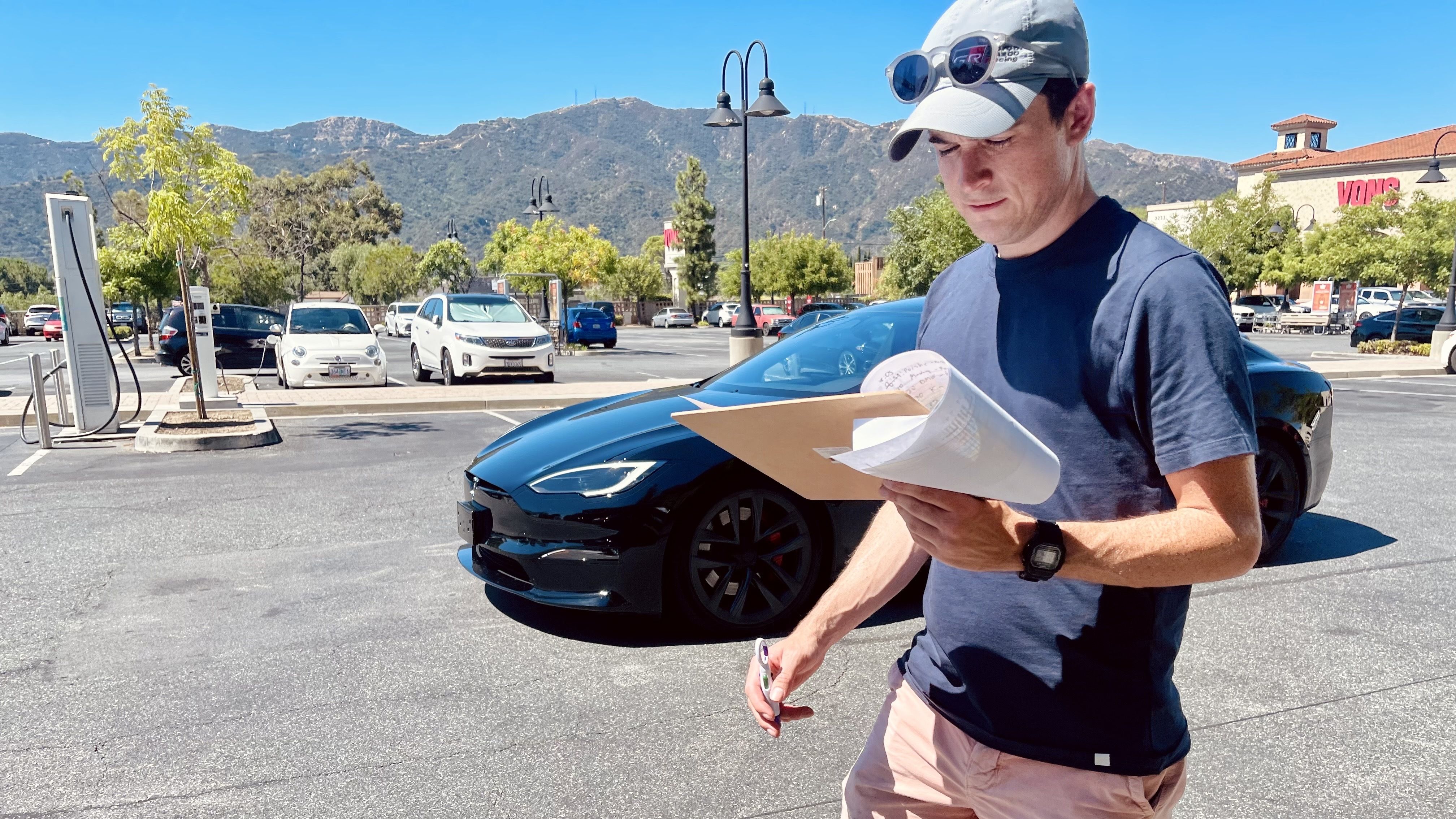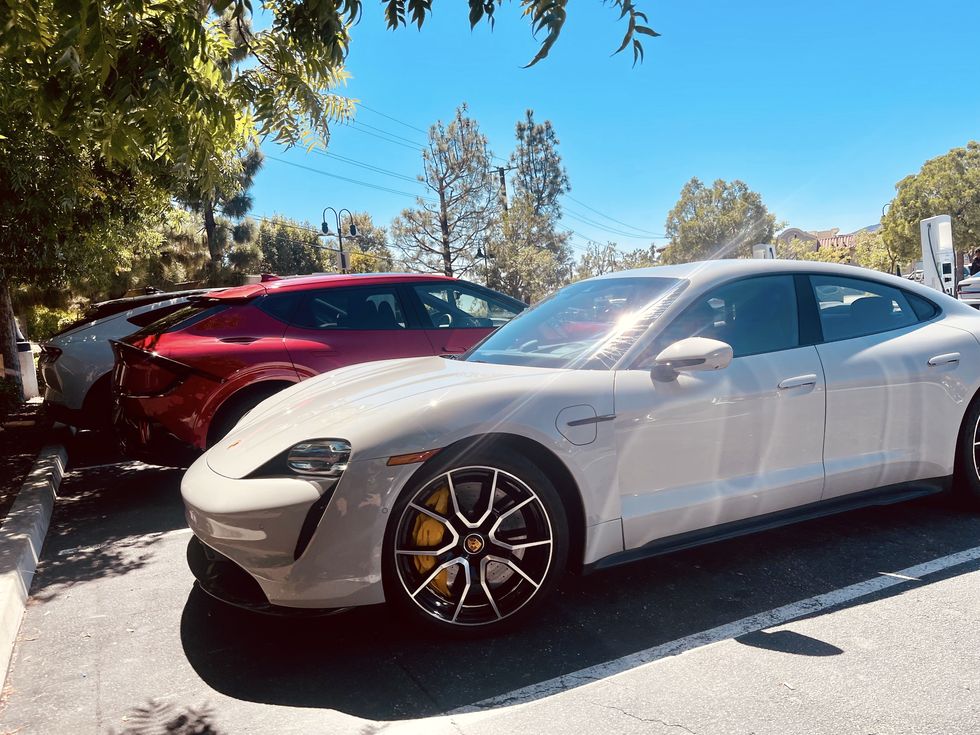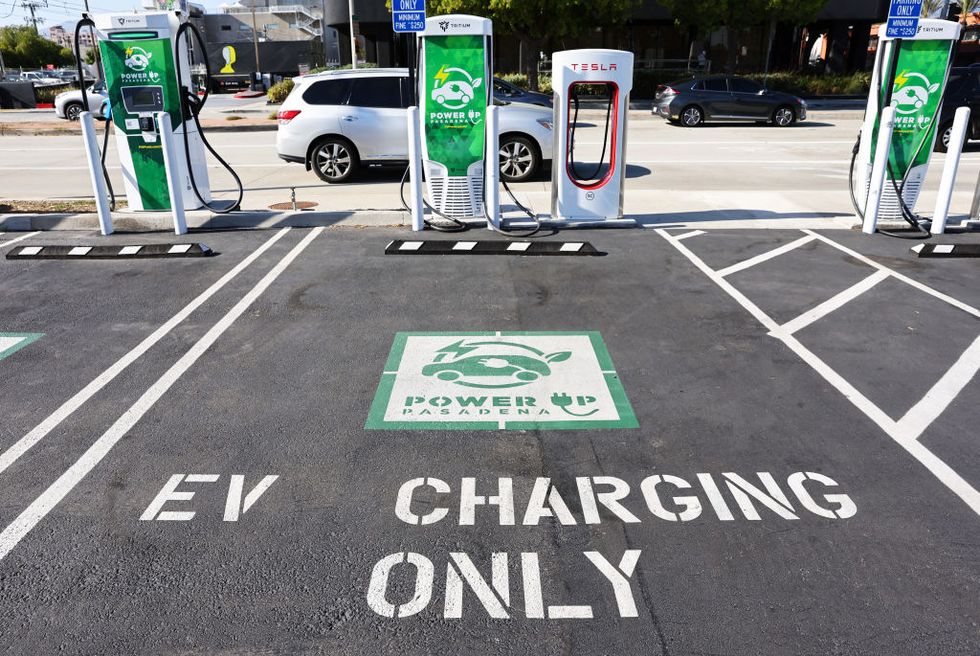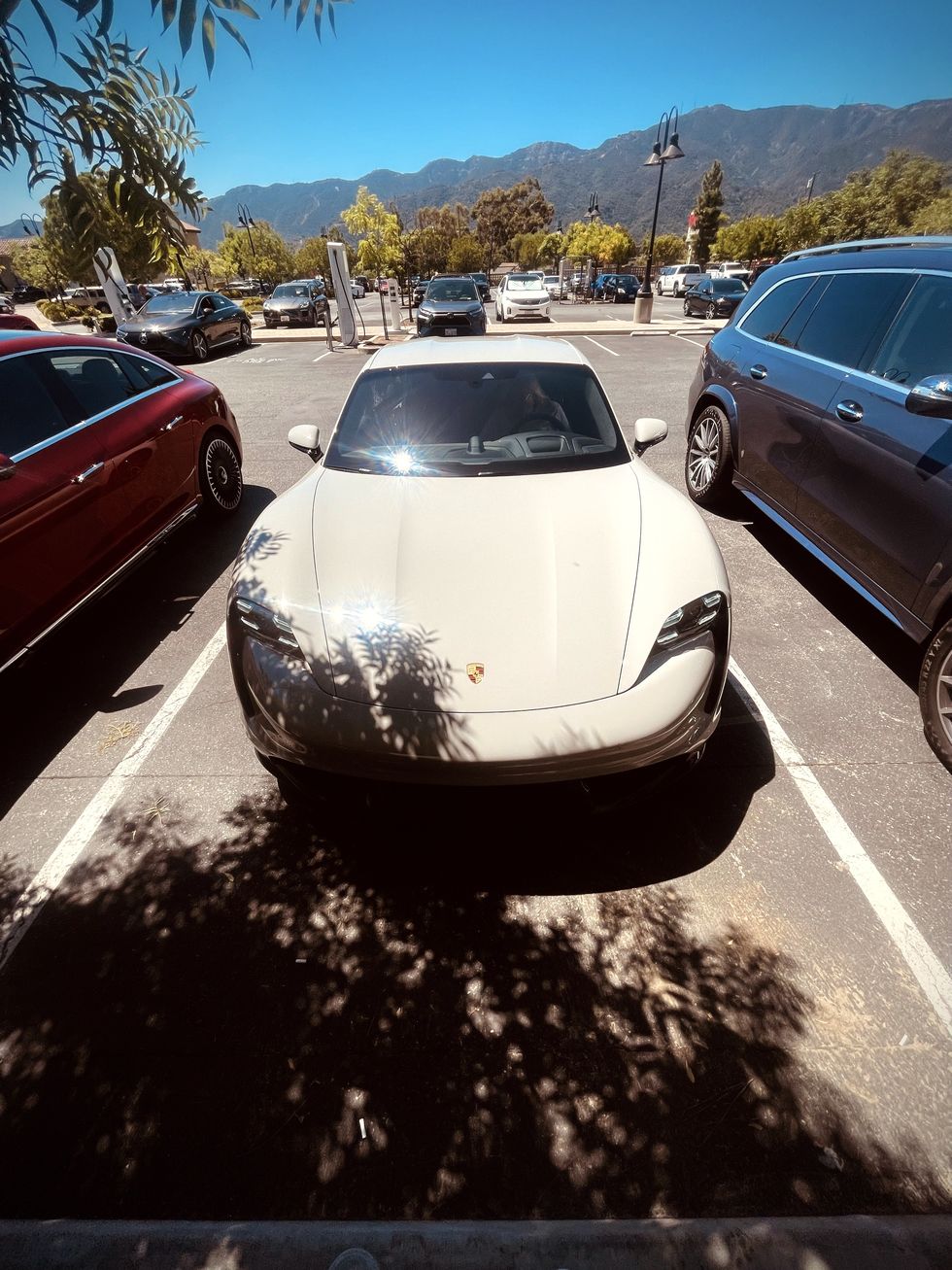One of the Electrify America fast chargers was already broken. Another de-rated itself from 150 kW to 30 kW. Oil seeped from its pristine white base. The credit card reader wasn’t working. A few hours later, it broke entirely. Four hours into our first Performance EV of the Year test, two out of three fast chargers at our primary charging location were down. There was a line of four cars waiting to use the remaining charger.
The mission was to keep six electric cars—a BMW i4 M50i, Ford Mach-E GT, Kia EV6 GT, Mercedes EQE AMG, Porsche Taycan Turbo, and Tesla Model S Plaid—charged up as four sets of editor pairs rotated through them. We knew it required careful planning. These cars couldn’t handle the 400-mile, high-speed road-drive days of Performance Car of the Year, let alone the two days of hardcore lapping that the internal-combustion cars have to survive. The current state of EVs demands its own test.
We had planned for calamity. Original ambitions had us considering race tracks across the country, mountain roads in Oregon, and serene towns in the Hudson Valley. But we have enough experience with public charging to know that you can’t count on any one charger working. We needed a test location where phenomenal roads were less than 10 miles from at least two medium to large fast-charging hubs.
The hills above Los Angeles were one of few reasonable options. They combine stunning pavement with access to one of the most well-developed charging networks in America, with multiple Electrify America stations within easy reach of Angeles Forest. The route we chose was 25 miles of canyon carving on Angeles Crest Highway, with steep hills and plenty of speed. Despite every car having a 200-mile range, I budgeted for only three runs between charges, and had the route start and end at the three-stall fast-charging station in La Crescenta, CA. Factoring in the ever-present threat of charging-station failure, I picked a three-stall backup location, and a further, bigger hive for if things got really bad.
With our primary station straining, I pointed the near-dead Kia EV6 GT toward our backup EA location. The EA app reported that two of the three fast chargers were still functioning. When I arrived, a post-it note warned of the truth. They weren’t working, either. Electrify America is the largest network of non-Tesla fast chargers, but the company’s first generation of charging stations isn’t exactly known for reliability.
I nursed the Kia to a EVGo Level 2 plug in a paid parking garage, where I arrived with 9 miles showing. Over about an hour I pulled 41 kWh, and left with a $21.26 credit card charge. Factor in the $4.00 for parking and I paid more for a hundred miles of range than if I was putting California premium in a BMW M340i.
When we assembled the following morning at the Wal-Mart in Burbank, it looked like a Seventies gas station. The row of eight fast chargers was flanked by a seven-car lineup. By lunchtime they had 12 cars waiting. A staffer returned with the BMW i4 M50i at 12 percent, so I took it and got in line. Two hours later, I hit 90 percent and set off after the rest of the staff.
But there is greener grass. All of the Tesla Supercharger stations we visited in the Plaid had open stalls and working, seamless, high-speed chargers. Plugging in was seamless. The payment, app, and charge-session-initiation issues we experienced at Electrify America were all gone. You plug in the car, it charges your account, and the electrons flow. Proof, then, that charging can work.
This time next year, even America’s best network will likely buckle under the strain. Ford, General Motors, Rivian, BMW, Mercedes, Hyundai, Kia, and a half-dozen other companies will grant their EV owners access to Tesla superchargers via adapter. By 2025, the NACS connector used by Tesla will be the factory plug on the majority of American-market EV models. The Superchargers we used had slack capacity, but it’s hard to imagine them handling the deluge.
Come PEVOTY time next year, I’m not sure our charging situation will be any better. Because when the chargers are overrun, everything falls apart. During my two days as charging czar, I had to improvise my way through a hundred awkward conversations. A charging hopeful in an EQS would pull up to the clogged charger, and—absent any official queue or line at the first station—I would have to explain the situation:
“That charger’s broken, that one has de-rated to essentially be a level 2 charger, and there are five cars in line for the last one. Each person is having to unplug and reauthorize multiple times and—because the line is so bad—a lot of people are charging to nearly 100 percent. So you’re welcome to get in line, but it’ll be at least two and a half hours before you’re going to get through it.”
That was usually enough to scare them off. But the conversations were uncomfortable, and the lack of on-site direction or in-app support meant EV owners were left to sort the pecking order for themselves. Some would ask others if they could hold their spot as they went to grab lunch, and were shocked upon return to realize that the person they talked to had given up, and no one else had any interest in letting them jump the line.
No one was all that surprised at the tension, or the lines, or the confusion. “At least you didn’t come in the evening,” one weary local told me. “It’s way worse.”
Our experience wasn’t just inconvenient. It was messy, frustrating, and stressful. I had to try to manage a group of random people who were understandably angry about a group of test cars hogging their chargers. But we were waiting in line like everyone else, using public chargers like everyone else, angry at things beyond our control like everyone else. Over 70 years of group tests for this magazine, we’ve never felt bad about tying up too many gas pumps.
This is what an immature system does. It generates friction, which can lead to heated moments. There are ways to solve this—more chargers, of course, but also lots designed to handle overflow, in-app queuing, or on-site directors keeping everyone in check. Right now, no one wants to deal with it. I know I didn’t. But if the great NACS migration happens before we confront these problems, things are going to get a whole lot worse before they get any better.

Reviews Editor
Arguably the most fickle member of the Road & Track staff, Reviews Editor Mack Hogan is likely the only person to ever cross shop an ND Miata with an Isuzu Vehicross. He founded the automotive reviews section of CNBC during his sophomore year of college and has been writing about cars ever since.
One of the Electrify America fast chargers was already broken. Another de-rated itself from 150 kW to 30 kW. Oil seeped from its pristine white base. The credit card reader wasn’t working. A few hours later, it broke entirely. Four hours into our first Performance EV of the Year test, two out of three fast chargers at our primary charging location were down. There was a line of four cars waiting to use the remaining charger.
The mission was to keep six electric cars—a BMW i4 M50i, Ford Mach-E GT, Kia EV6 GT, Mercedes EQE AMG, Porsche Taycan Turbo, and Tesla Model S Plaid—charged up as four sets of editor pairs rotated through them. We knew it required careful planning. These cars couldn’t handle the 400-mile, high-speed road-drive days of Performance Car of the Year, let alone the two days of hardcore lapping that the internal-combustion cars have to survive. The current state of EVs demands its own test.
We had planned for calamity. Original ambitions had us considering race tracks across the country, mountain roads in Oregon, and serene towns in the Hudson Valley. But we have enough experience with public charging to know that you can’t count on any one charger working. We needed a test location where phenomenal roads were less than 10 miles from at least two medium to large fast-charging hubs.
The hills above Los Angeles were one of few reasonable options. They combine stunning pavement with access to one of the most well-developed charging networks in America, with multiple Electrify America stations within easy reach of Angeles Forest. The route we chose was 25 miles of canyon carving on Angeles Crest Highway, with steep hills and plenty of speed. Despite every car having a 200-mile range, I budgeted for only three runs between charges, and had the route start and end at the three-stall fast-charging station in La Crescenta, CA. Factoring in the ever-present threat of charging-station failure, I picked a three-stall backup location, and a further, bigger hive for if things got really bad.
With our primary station straining, I pointed the near-dead Kia EV6 GT toward our backup EA location. The EA app reported that two of the three fast chargers were still functioning. When I arrived, a post-it note warned of the truth. They weren’t working, either. Electrify America is the largest network of non-Tesla fast chargers, but the company’s first generation of charging stations isn’t exactly known for reliability.
I nursed the Kia to a EVGo Level 2 plug in a paid parking garage, where I arrived with 9 miles showing. Over about an hour I pulled 41 kWh, and left with a $21.26 credit card charge. Factor in the $4.00 for parking and I paid more for a hundred miles of range than if I was putting California premium in a BMW M340i.
When we assembled the following morning at the Wal-Mart in Burbank, it looked like a Seventies gas station. The row of eight fast chargers was flanked by a seven-car lineup. By lunchtime they had 12 cars waiting. A staffer returned with the BMW i4 M50i at 12 percent, so I took it and got in line. Two hours later, I hit 90 percent and set off after the rest of the staff.
But there is greener grass. All of the Tesla Supercharger stations we visited in the Plaid had open stalls and working, seamless, high-speed chargers. Plugging in was seamless. The payment, app, and charge-session-initiation issues we experienced at Electrify America were all gone. You plug in the car, it charges your account, and the electrons flow. Proof, then, that charging can work.
This time next year, even America’s best network will likely buckle under the strain. Ford, General Motors, Rivian, BMW, Mercedes, Hyundai, Kia, and a half-dozen other companies will grant their EV owners access to Tesla superchargers via adapter. By 2025, the NACS connector used by Tesla will be the factory plug on the majority of American-market EV models. The Superchargers we used had slack capacity, but it’s hard to imagine them handling the deluge.
Come PEVOTY time next year, I’m not sure our charging situation will be any better. Because when the chargers are overrun, everything falls apart. During my two days as charging czar, I had to improvise my way through a hundred awkward conversations. A charging hopeful in an EQS would pull up to the clogged charger, and—absent any official queue or line at the first station—I would have to explain the situation:
“That charger’s broken, that one has de-rated to essentially be a level 2 charger, and there are five cars in line for the last one. Each person is having to unplug and reauthorize multiple times and—because the line is so bad—a lot of people are charging to nearly 100 percent. So you’re welcome to get in line, but it’ll be at least two and a half hours before you’re going to get through it.”
That was usually enough to scare them off. But the conversations were uncomfortable, and the lack of on-site direction or in-app support meant EV owners were left to sort the pecking order for themselves. Some would ask others if they could hold their spot as they went to grab lunch, and were shocked upon return to realize that the person they talked to had given up, and no one else had any interest in letting them jump the line.
No one was all that surprised at the tension, or the lines, or the confusion. “At least you didn’t come in the evening,” one weary local told me. “It’s way worse.”
Our experience wasn’t just inconvenient. It was messy, frustrating, and stressful. I had to try to manage a group of random people who were understandably angry about a group of test cars hogging their chargers. But we were waiting in line like everyone else, using public chargers like everyone else, angry at things beyond our control like everyone else. Over 70 years of group tests for this magazine, we’ve never felt bad about tying up too many gas pumps.
This is what an immature system does. It generates friction, which can lead to heated moments. There are ways to solve this—more chargers, of course, but also lots designed to handle overflow, in-app queuing, or on-site directors keeping everyone in check. Right now, no one wants to deal with it. I know I didn’t. But if the great NACS migration happens before we confront these problems, things are going to get a whole lot worse before they get any better.

Reviews Editor
Arguably the most fickle member of the Road & Track staff, Reviews Editor Mack Hogan is likely the only person to ever cross shop an ND Miata with an Isuzu Vehicross. He founded the automotive reviews section of CNBC during his sophomore year of college and has been writing about cars ever since.
One of the Electrify America fast chargers was already broken. Another de-rated itself from 150 kW to 30 kW. Oil seeped from its pristine white base. The credit card reader wasn’t working. A few hours later, it broke entirely. Four hours into our first Performance EV of the Year test, two out of three fast chargers at our primary charging location were down. There was a line of four cars waiting to use the remaining charger.
The mission was to keep six electric cars—a BMW i4 M50i, Ford Mach-E GT, Kia EV6 GT, Mercedes EQE AMG, Porsche Taycan Turbo, and Tesla Model S Plaid—charged up as four sets of editor pairs rotated through them. We knew it required careful planning. These cars couldn’t handle the 400-mile, high-speed road-drive days of Performance Car of the Year, let alone the two days of hardcore lapping that the internal-combustion cars have to survive. The current state of EVs demands its own test.
We had planned for calamity. Original ambitions had us considering race tracks across the country, mountain roads in Oregon, and serene towns in the Hudson Valley. But we have enough experience with public charging to know that you can’t count on any one charger working. We needed a test location where phenomenal roads were less than 10 miles from at least two medium to large fast-charging hubs.
The hills above Los Angeles were one of few reasonable options. They combine stunning pavement with access to one of the most well-developed charging networks in America, with multiple Electrify America stations within easy reach of Angeles Forest. The route we chose was 25 miles of canyon carving on Angeles Crest Highway, with steep hills and plenty of speed. Despite every car having a 200-mile range, I budgeted for only three runs between charges, and had the route start and end at the three-stall fast-charging station in La Crescenta, CA. Factoring in the ever-present threat of charging-station failure, I picked a three-stall backup location, and a further, bigger hive for if things got really bad.
With our primary station straining, I pointed the near-dead Kia EV6 GT toward our backup EA location. The EA app reported that two of the three fast chargers were still functioning. When I arrived, a post-it note warned of the truth. They weren’t working, either. Electrify America is the largest network of non-Tesla fast chargers, but the company’s first generation of charging stations isn’t exactly known for reliability.
I nursed the Kia to a EVGo Level 2 plug in a paid parking garage, where I arrived with 9 miles showing. Over about an hour I pulled 41 kWh, and left with a $21.26 credit card charge. Factor in the $4.00 for parking and I paid more for a hundred miles of range than if I was putting California premium in a BMW M340i.
When we assembled the following morning at the Wal-Mart in Burbank, it looked like a Seventies gas station. The row of eight fast chargers was flanked by a seven-car lineup. By lunchtime they had 12 cars waiting. A staffer returned with the BMW i4 M50i at 12 percent, so I took it and got in line. Two hours later, I hit 90 percent and set off after the rest of the staff.
But there is greener grass. All of the Tesla Supercharger stations we visited in the Plaid had open stalls and working, seamless, high-speed chargers. Plugging in was seamless. The payment, app, and charge-session-initiation issues we experienced at Electrify America were all gone. You plug in the car, it charges your account, and the electrons flow. Proof, then, that charging can work.
This time next year, even America’s best network will likely buckle under the strain. Ford, General Motors, Rivian, BMW, Mercedes, Hyundai, Kia, and a half-dozen other companies will grant their EV owners access to Tesla superchargers via adapter. By 2025, the NACS connector used by Tesla will be the factory plug on the majority of American-market EV models. The Superchargers we used had slack capacity, but it’s hard to imagine them handling the deluge.
Come PEVOTY time next year, I’m not sure our charging situation will be any better. Because when the chargers are overrun, everything falls apart. During my two days as charging czar, I had to improvise my way through a hundred awkward conversations. A charging hopeful in an EQS would pull up to the clogged charger, and—absent any official queue or line at the first station—I would have to explain the situation:
“That charger’s broken, that one has de-rated to essentially be a level 2 charger, and there are five cars in line for the last one. Each person is having to unplug and reauthorize multiple times and—because the line is so bad—a lot of people are charging to nearly 100 percent. So you’re welcome to get in line, but it’ll be at least two and a half hours before you’re going to get through it.”
That was usually enough to scare them off. But the conversations were uncomfortable, and the lack of on-site direction or in-app support meant EV owners were left to sort the pecking order for themselves. Some would ask others if they could hold their spot as they went to grab lunch, and were shocked upon return to realize that the person they talked to had given up, and no one else had any interest in letting them jump the line.
No one was all that surprised at the tension, or the lines, or the confusion. “At least you didn’t come in the evening,” one weary local told me. “It’s way worse.”
Our experience wasn’t just inconvenient. It was messy, frustrating, and stressful. I had to try to manage a group of random people who were understandably angry about a group of test cars hogging their chargers. But we were waiting in line like everyone else, using public chargers like everyone else, angry at things beyond our control like everyone else. Over 70 years of group tests for this magazine, we’ve never felt bad about tying up too many gas pumps.
This is what an immature system does. It generates friction, which can lead to heated moments. There are ways to solve this—more chargers, of course, but also lots designed to handle overflow, in-app queuing, or on-site directors keeping everyone in check. Right now, no one wants to deal with it. I know I didn’t. But if the great NACS migration happens before we confront these problems, things are going to get a whole lot worse before they get any better.

Reviews Editor
Arguably the most fickle member of the Road & Track staff, Reviews Editor Mack Hogan is likely the only person to ever cross shop an ND Miata with an Isuzu Vehicross. He founded the automotive reviews section of CNBC during his sophomore year of college and has been writing about cars ever since.
One of the Electrify America fast chargers was already broken. Another de-rated itself from 150 kW to 30 kW. Oil seeped from its pristine white base. The credit card reader wasn’t working. A few hours later, it broke entirely. Four hours into our first Performance EV of the Year test, two out of three fast chargers at our primary charging location were down. There was a line of four cars waiting to use the remaining charger.
The mission was to keep six electric cars—a BMW i4 M50i, Ford Mach-E GT, Kia EV6 GT, Mercedes EQE AMG, Porsche Taycan Turbo, and Tesla Model S Plaid—charged up as four sets of editor pairs rotated through them. We knew it required careful planning. These cars couldn’t handle the 400-mile, high-speed road-drive days of Performance Car of the Year, let alone the two days of hardcore lapping that the internal-combustion cars have to survive. The current state of EVs demands its own test.
We had planned for calamity. Original ambitions had us considering race tracks across the country, mountain roads in Oregon, and serene towns in the Hudson Valley. But we have enough experience with public charging to know that you can’t count on any one charger working. We needed a test location where phenomenal roads were less than 10 miles from at least two medium to large fast-charging hubs.
The hills above Los Angeles were one of few reasonable options. They combine stunning pavement with access to one of the most well-developed charging networks in America, with multiple Electrify America stations within easy reach of Angeles Forest. The route we chose was 25 miles of canyon carving on Angeles Crest Highway, with steep hills and plenty of speed. Despite every car having a 200-mile range, I budgeted for only three runs between charges, and had the route start and end at the three-stall fast-charging station in La Crescenta, CA. Factoring in the ever-present threat of charging-station failure, I picked a three-stall backup location, and a further, bigger hive for if things got really bad.
With our primary station straining, I pointed the near-dead Kia EV6 GT toward our backup EA location. The EA app reported that two of the three fast chargers were still functioning. When I arrived, a post-it note warned of the truth. They weren’t working, either. Electrify America is the largest network of non-Tesla fast chargers, but the company’s first generation of charging stations isn’t exactly known for reliability.
I nursed the Kia to a EVGo Level 2 plug in a paid parking garage, where I arrived with 9 miles showing. Over about an hour I pulled 41 kWh, and left with a $21.26 credit card charge. Factor in the $4.00 for parking and I paid more for a hundred miles of range than if I was putting California premium in a BMW M340i.
When we assembled the following morning at the Wal-Mart in Burbank, it looked like a Seventies gas station. The row of eight fast chargers was flanked by a seven-car lineup. By lunchtime they had 12 cars waiting. A staffer returned with the BMW i4 M50i at 12 percent, so I took it and got in line. Two hours later, I hit 90 percent and set off after the rest of the staff.
But there is greener grass. All of the Tesla Supercharger stations we visited in the Plaid had open stalls and working, seamless, high-speed chargers. Plugging in was seamless. The payment, app, and charge-session-initiation issues we experienced at Electrify America were all gone. You plug in the car, it charges your account, and the electrons flow. Proof, then, that charging can work.
This time next year, even America’s best network will likely buckle under the strain. Ford, General Motors, Rivian, BMW, Mercedes, Hyundai, Kia, and a half-dozen other companies will grant their EV owners access to Tesla superchargers via adapter. By 2025, the NACS connector used by Tesla will be the factory plug on the majority of American-market EV models. The Superchargers we used had slack capacity, but it’s hard to imagine them handling the deluge.
Come PEVOTY time next year, I’m not sure our charging situation will be any better. Because when the chargers are overrun, everything falls apart. During my two days as charging czar, I had to improvise my way through a hundred awkward conversations. A charging hopeful in an EQS would pull up to the clogged charger, and—absent any official queue or line at the first station—I would have to explain the situation:
“That charger’s broken, that one has de-rated to essentially be a level 2 charger, and there are five cars in line for the last one. Each person is having to unplug and reauthorize multiple times and—because the line is so bad—a lot of people are charging to nearly 100 percent. So you’re welcome to get in line, but it’ll be at least two and a half hours before you’re going to get through it.”
That was usually enough to scare them off. But the conversations were uncomfortable, and the lack of on-site direction or in-app support meant EV owners were left to sort the pecking order for themselves. Some would ask others if they could hold their spot as they went to grab lunch, and were shocked upon return to realize that the person they talked to had given up, and no one else had any interest in letting them jump the line.
No one was all that surprised at the tension, or the lines, or the confusion. “At least you didn’t come in the evening,” one weary local told me. “It’s way worse.”
Our experience wasn’t just inconvenient. It was messy, frustrating, and stressful. I had to try to manage a group of random people who were understandably angry about a group of test cars hogging their chargers. But we were waiting in line like everyone else, using public chargers like everyone else, angry at things beyond our control like everyone else. Over 70 years of group tests for this magazine, we’ve never felt bad about tying up too many gas pumps.
This is what an immature system does. It generates friction, which can lead to heated moments. There are ways to solve this—more chargers, of course, but also lots designed to handle overflow, in-app queuing, or on-site directors keeping everyone in check. Right now, no one wants to deal with it. I know I didn’t. But if the great NACS migration happens before we confront these problems, things are going to get a whole lot worse before they get any better.

Reviews Editor
Arguably the most fickle member of the Road & Track staff, Reviews Editor Mack Hogan is likely the only person to ever cross shop an ND Miata with an Isuzu Vehicross. He founded the automotive reviews section of CNBC during his sophomore year of college and has been writing about cars ever since.


















